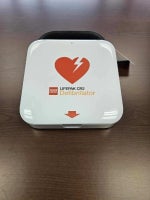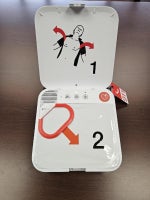Environmental Health and Safety
Mailing Address
Cleveland State University
2121 Euclid Avenue PS 229
Cleveland, OH 44115-2214
Campus Location
Plant Services, Room 229
1802 East 25th Street
Phone: 216-687-2500
Fax: 216-687-9346
Automated External Defibrillators

Cleveland State University has Automated External Defibrillators (AED) located in certain campus buildings. CSU Police vehicles are also equipped with AEDs. AEDs are an effective tool to address individuals experiencing sudden cardiac arrest.
Sudden cardiac arrests are often the result of abnormal heart rhythms, the majority of which are ventricular fibrillation. Ventricular fibrillation is a condition where the heart's electrical impulses become irregular and chaotic, resulting in blood no longer being pumped efficiently throughout the body.
How an AED Works

Once turned on, prompts appear that guide AED users through the process. One of the initial prompts instructs the user to connect the AED to the victim by placing adhesive pads on the victim's chest.
The AED analyzes the victim's heart rate to determine if a shock is needed. If the AED unit does not detect an abnormal heart rhythm, no shock can be delivered. If a shock is needed, the AED will prompt the user to press a button that will deliver the shock.
the AED Program.
Locations
| Building | Address | Location |
|---|---|---|
| AC - Administration Center | 2303 Chester Ave | Mailroom |
| CH - College of Health | 1840 Payne Ave | Vestibule leading to training room |
| CS - Campus Safety | 2420 Chester | 1st Fl near elevator |
| CS - Campus Safety | 2112 Euclid | 1st Fl behind elevator |
| CS - Campus Safety | 1840 Chester | Lobby |
| CS - Campus Safety | 1840 Chester | Mobile unit 1 |
| CS - Campus Safety | 1840 Chester | Mobile unit 2 |
| EC 4 - Euclid Commons 4 | 1840 Chester | Mobile unit 3 |
| The Edge | 1840 Chester | Mobile unit 4 |
| FH - Fenn Hall | 2450 Euclid | 1st Fl lobby |
| HS - Health Sciences | 1750 Euclid | Main desk |
| JH - Julka Hall | 1960 East 24th | 3rd Fl near elevator |
| KFH - Krenzler Field | 2501 Euclid | 1st Fl near elevator |
| KFH - Krenzler Field | 2485 Euclid | 1st Fl N-S Corridor |
| LA - Langston | 1840 Payne | Training room |
| EC 4 - Euclid Commons 4 - Marketing | 2502 Euclid Commons, University Marketing | Rm 181 |
| PE - Physical Education | 2451 Euclid | Pool Deck |
| PE - Physical Education | 2451 Euclid | B60 |
| PE - Physical Education | 2451 Euclid | Outside SB6 |
| PE - Physical Education | 2451 Euclid | 1st Fl near elevator |
| PE - Physical Education | 2451 Euclid | Woodling Gym |
| PS - Plant Services | 1802 East 25th | EHS back cabinet - Spare 1 |
| PS - Plant Services | 1802 East 25th | EHS back cabinet - Spare 2 |
| RC - Rec Center | 2420 Chester | Stairs behind main desk |
| RC - Rec Center | 2420 Chester | Main Desk |
| RC - Rec Center | 2420 Chester | Fitness/Wellness Suite (RC 166) |
| RC - Rec Center | 2420 Chester | 2nd Fl East Stairs |
| RT - Rhodes Tower | 2121 Euclid, Rhodes Tower | Circulation Desk |
| RT - Rhodes Tower | 2121 Euclid, Rhodes Tower | 10th Fl near elevator |
| RT - Rhodes Tower | 2121 Euclid, Rhodes Tower | 11th Fl near elevator |
| SC - Student Center | 2121 Euclid | Info desk |
| SC - Student Center | 2121 Euclid | 3rd Fl |
| Tennis Pavilion | 2005 Chester | Near restrooms |
| UR - Urban Affairs | 1717 Euclid | 1st Fl near elevator |
| UR - Urban Affairs | 1717 Euclid | 2nd Fl near elevator |
| UR - Urban Affairs | 1717 Euclid | 3rd Fl near elevator |
| WO - Wolstein Center | 2000 Prospect | Trainer's room |
| WO - Wolstein Center | 2000 Prospect | Lobby box office |
| WO - Wolstein Center | 2000 Prospect | Practice B-ball gym |
| WH - Washkewicz Hall | 2300 Chester | Outside 305 |
Mailing Address
Cleveland State University
2121 Euclid Avenue PS 229
Cleveland, OH 44115-2214
Campus Location
Plant Services, Room 229
1802 East 25th Street
Phone: 216-687-2500
Fax: 216-687-9346